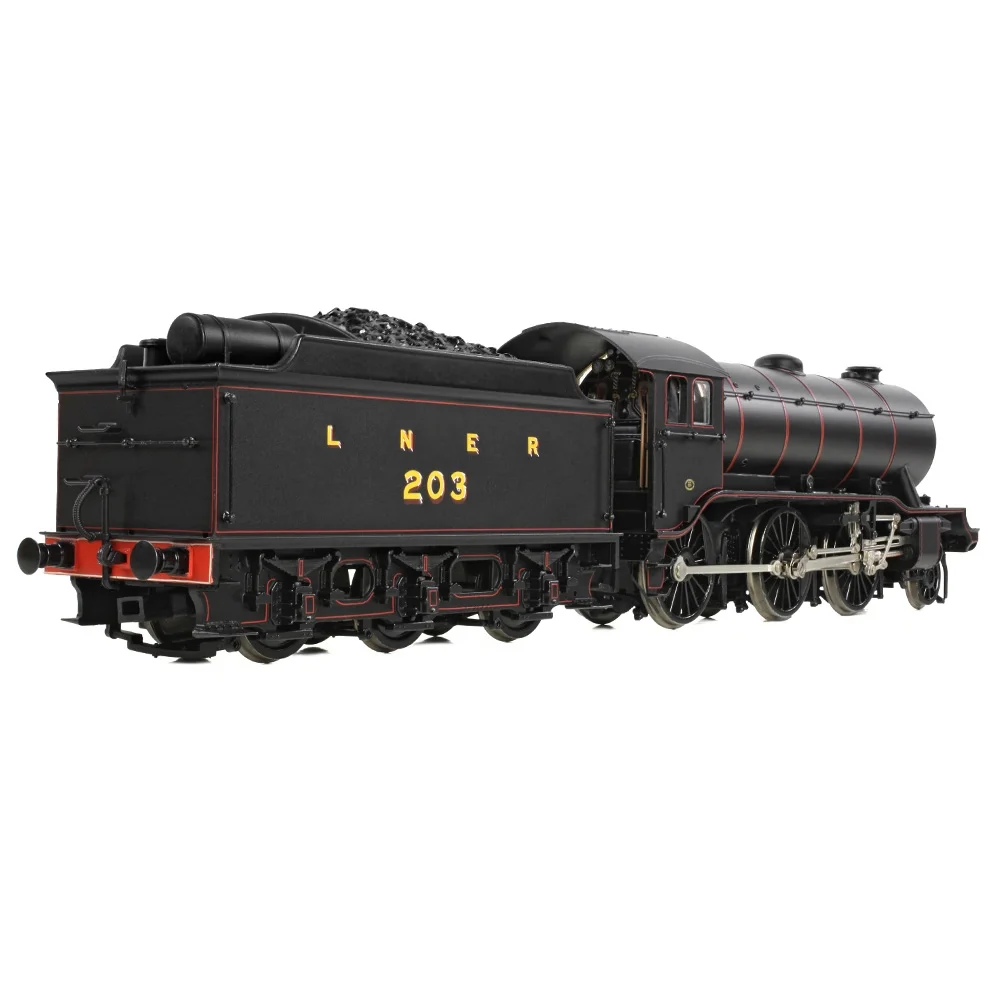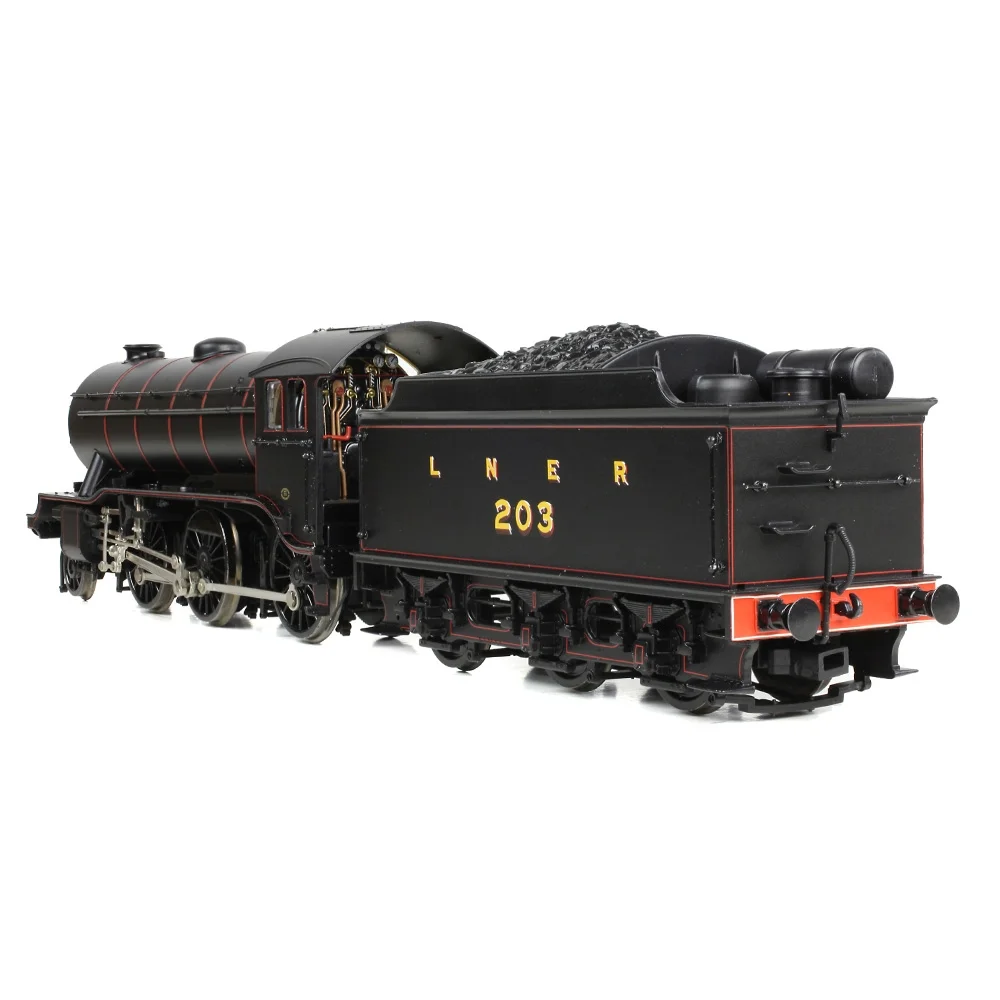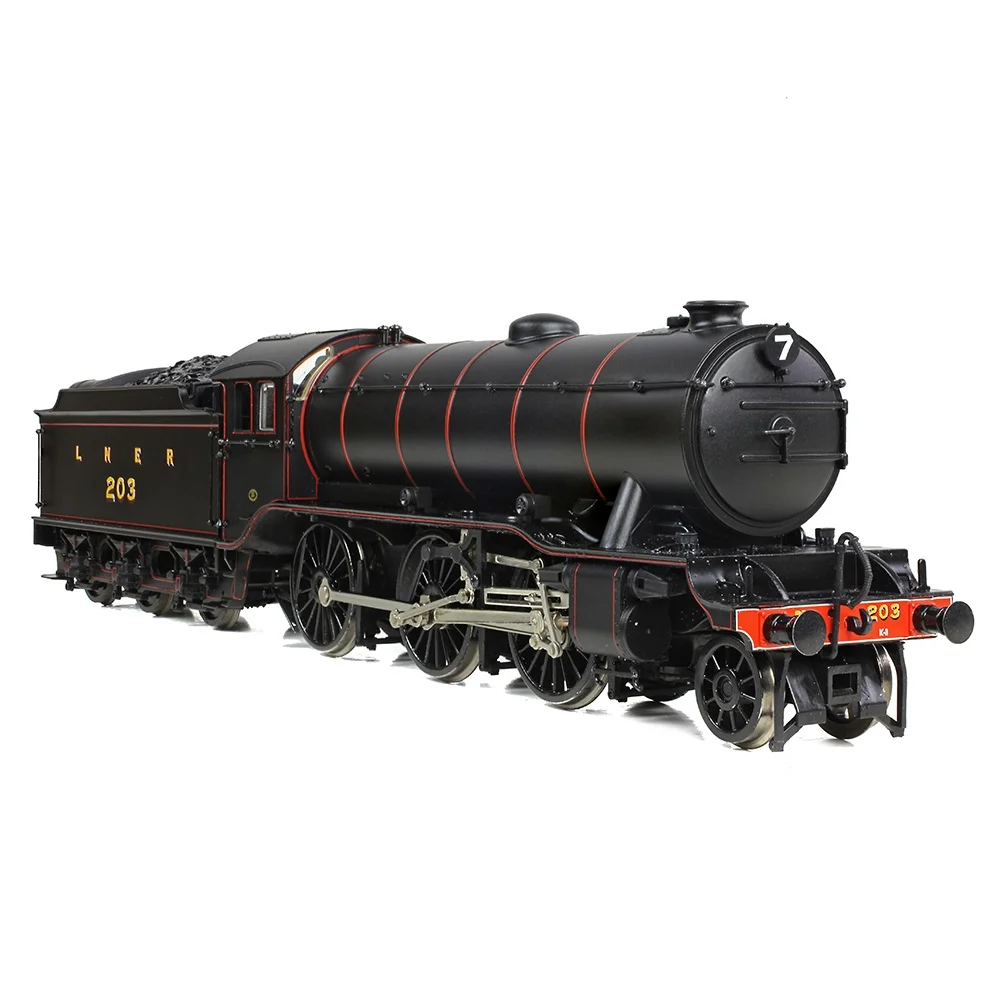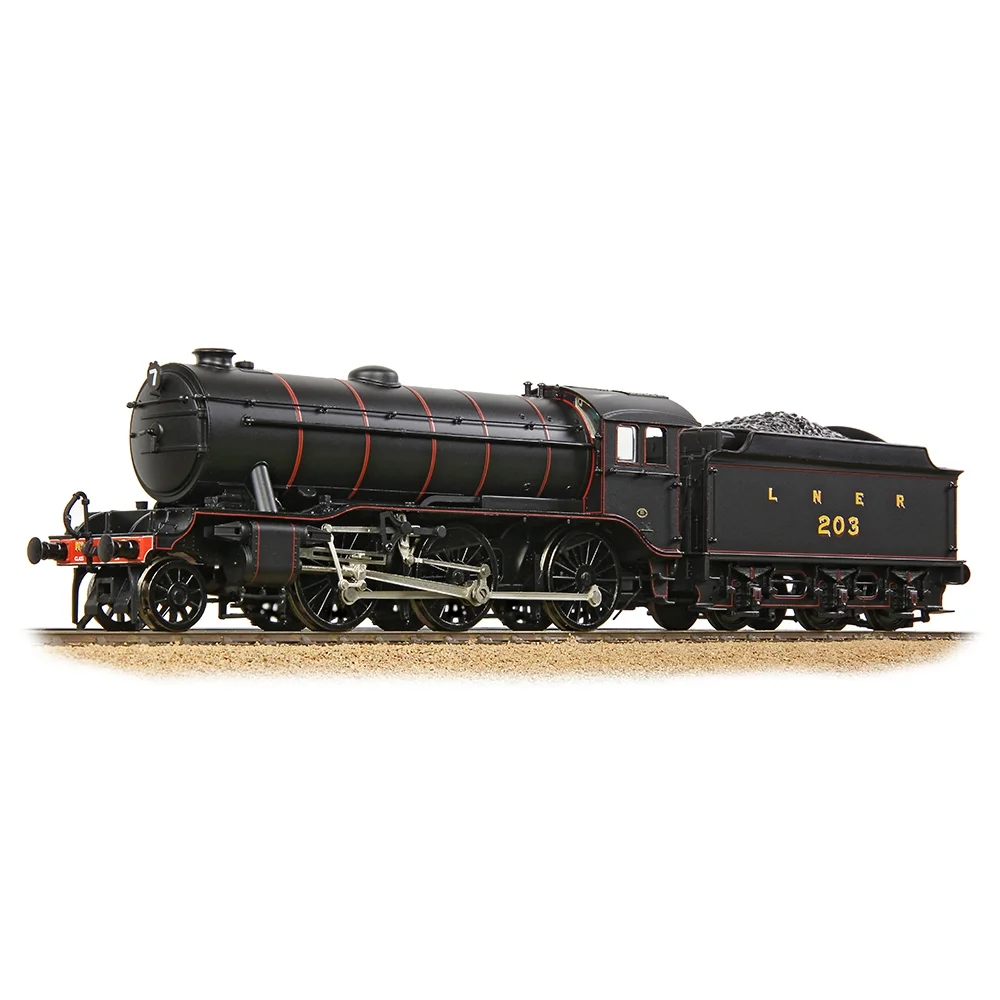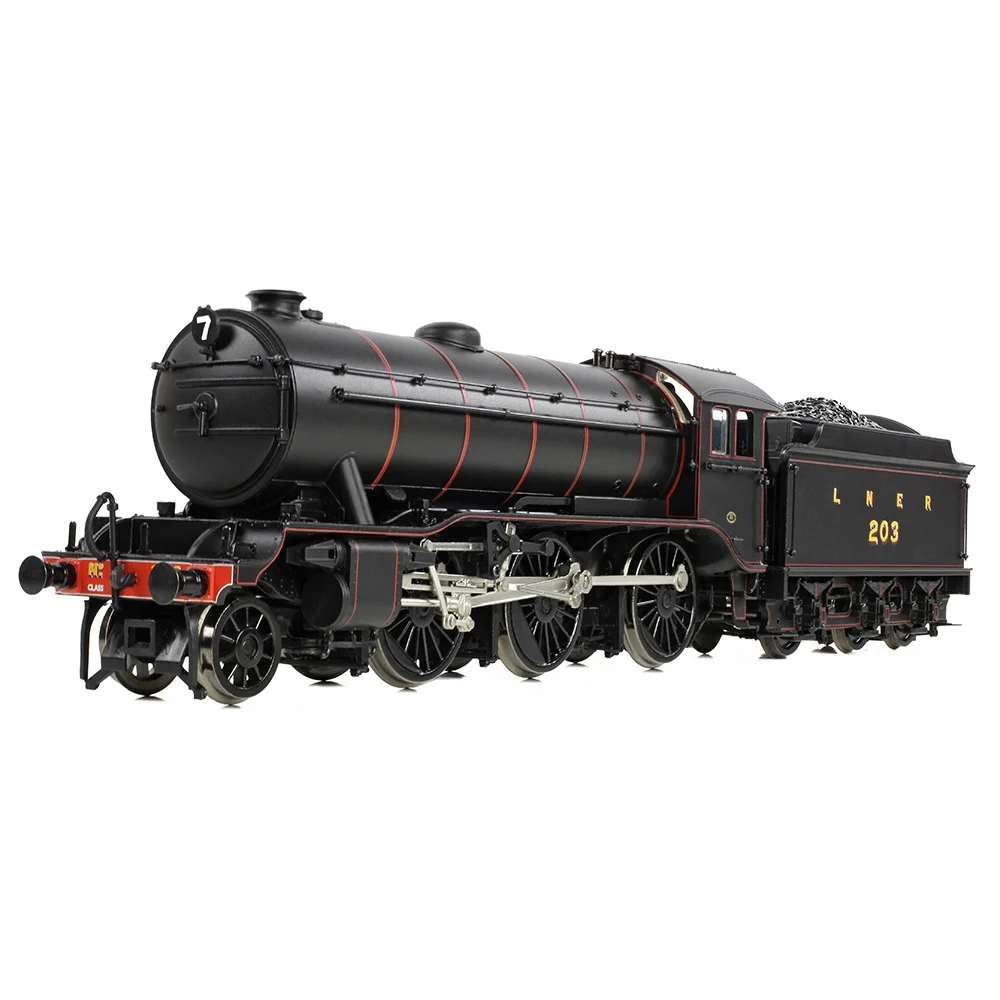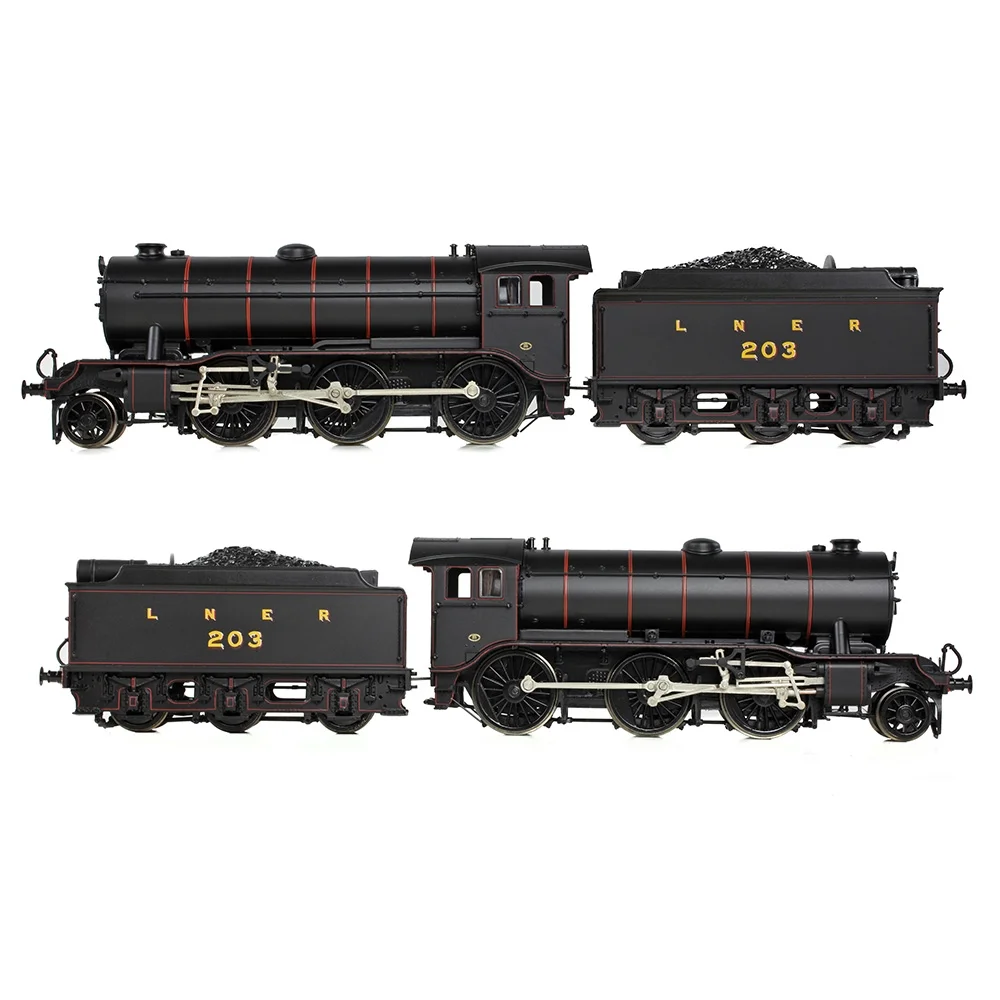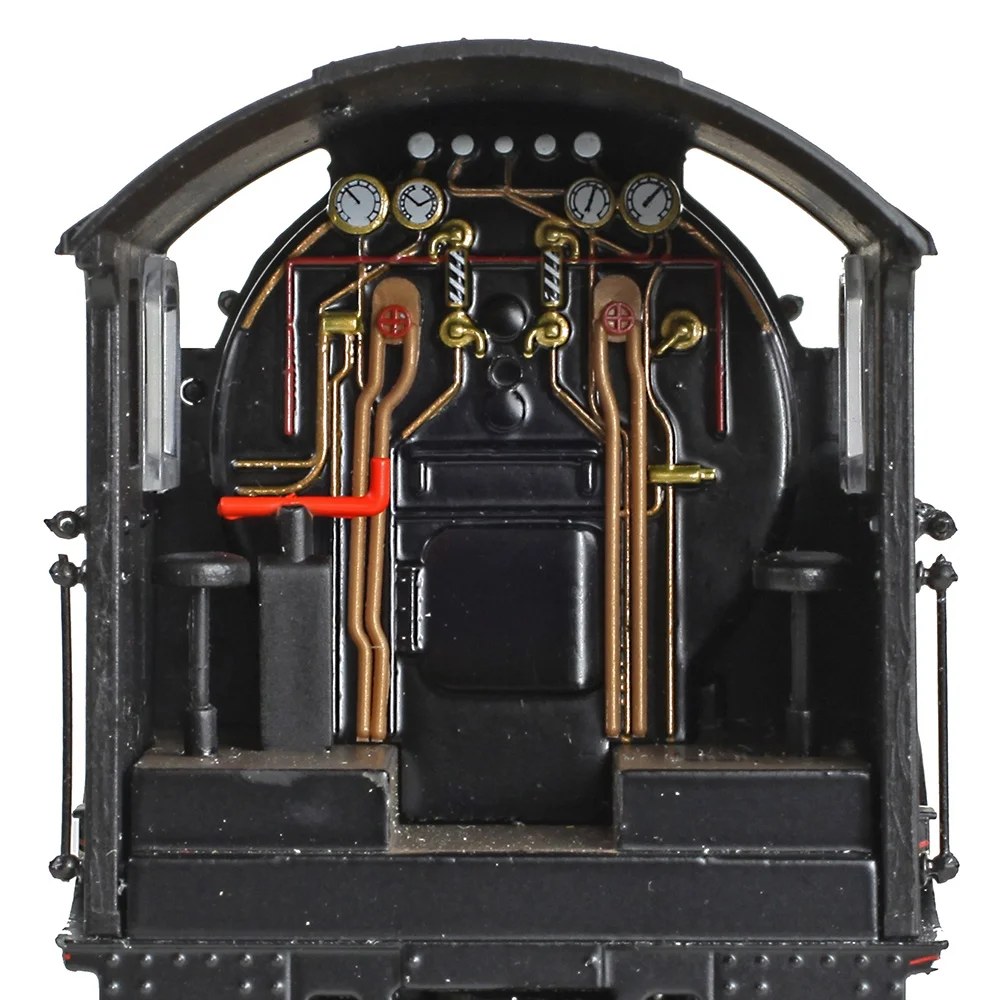Bachmann 32-279B
London & North Eastern Railway K3 203 London & North Eastern Railway Lined Black
Tooling
Introduced in 2004, Bachmann's tooling for the Great Northern Railway Class H4—later reclassified as the London & North Eastern Railway (LNER) Class K3—brought to life one of Nigel Gresley's most influential mixed-traffic locomotive designs. Known affectionately as the "Jazzers" due to their syncopated exhaust beat, the K3s were a hallmark of early 20th-century British railway engineering, with 193 examples built between 1920 and 1937.
Tooling Features
- Scale: OO gauge (1:76)
- Construction: Diecast running plate and chassis for weight and strength; precision-moulded plastic bodyshell with separately fitted details
- Detailing: Includes turned brass safety valves, metal handrails, lamp irons, sprung buffers, brake rigging, sandpipes, and fully detailed cab interiors
- Couplings: NEM pockets with tension-lock couplers
- Tender: Adjustable drawbar, realistic coal load, separately applied details including lamp irons and water scoop
Mechanical & Electrical
- Motor: 3-pole motor located in the locomotive
- Drive: Loco-driven wheels with pickups on driving wheels only
- Minimum Radius: Compatible with second radius curves (438mm)
- Weighting: Metal components within chassis and tender for improved adhesion
- Lighting: No factory lighting fitted
DCC Capability
- Socket: 8-pin DCC-ready
- Sound Installation: Compatible with Zimo MX648/MX645 decoders and stay-alive capacitors; speaker installation possible with boiler weight removal
Liveries Produced
- LNER Black (1923–1947)
- LNER Green (1923–1947)
- BR Black with Early Emblem (1949–1957)
- BR Black with Late Crest (1957–1968)
Reviews & Commentary
The Bachmann K3 has been praised for its smooth running, accurate proportions, and high-quality detailing. Reviewers have noted its impressive pulling power and weight, though some have commented on minor issues such as wheel size discrepancies and livery detailing. Social media and forums have discussed the accuracy of lining and tender details, with general consensus favouring the model's overall authenticity and performance.
Media Coverage
- Sam'sTrains Unboxing & Review – Detailed examination and performance test
- Leopard Street Model Railway – DCC installation and running
- OO Neal Restoration & Weathering – Custom detailing
Additional Notes
The tooling has supported multiple variants including stepped and flared tenders, and has been used in special releases such as the Stockton & Darlington centenary model. Enthusiasts have also successfully converted models to EM gauge and installed advanced DCC sound systems, showcasing the tooling's flexibility and enduring popularity.
Bachmann's Description & Specifications
The Branchline model of Gresley’s 2-6-0 mogul employs a diecast running plate and locomotive chassis to provide an impressive weight, ensuring that the model’s strength and versatility is true to prototype. Meanwhile, those components produced in plastic are precision moulded, with details such as rivets and boiler bands crisply reproduced. Separate parts are then added to enhance the authenticity of the model further, from the metal handrails and lamp irons to the safety valves and sprung buffers, each of which are turned brass. Within the cab, controls, dials and pipework are all moulded authentically and decorated accordingly. Multiple parts are added to the locomotive’s chassis, with brake blocks and brake rigging, footsteps and metal wire sandpipes all fitted separately.
Moving to the tender and the locomotive to tender drawbar is adjustable to suit different layout conditions whilst the tender itself is finely moulded, with several separately applied details including the lamp irons, handrails, handwheels and sprung metal buffers. A realistic coal load is included, with the empty coal space modelled below, whilst the tender chassis includes brake rigging and the water scoop.
This model of No. 203 forms part of our Railway Celebrations range and depicts the locomotive that took part in the 100th Anniversary celebrations of the opening of the Stockton & Darlington Railway. In 1925, to mark the centenary, a celebration of railways featuring locomotives from the past century was put on by the London & North Eastern Railway (LNER). Opened by the Duke and Duchess of York – later King Geroge VI and Queen Elizabeth – a procession of locomotives took place over some six miles of line between Stockton and Darlington, passing the royal grandstand and delighting the hundreds of thousands of onlookers who turned out to witness the celebrations.
The parade of 53 locomotives intended to showcase the evolution of the steam locomotive, from the early examples to modern designs and included LNER K3 No. 203 which was one of the youngest locos on show, having been outshopped by the LNER’s Darlington Works earlier that year. No. 203 was renumbered to 1860 under the LNER’s 1946 renumbering programme, becoming 61860 upon Nationalisation when it entered the British Railways fleet. The locomotive enjoyed a career spanning more than 35 years before it was withdrawn in 1961 and subsequently scrapped.
The livery application is what really brings this new K3 to life, with a rich application of black paintwork augmented by the lining which is applied with pinpoint precision. Numbering and lettering is reproduced in high definition, resulting in a model fit for any collection.
MODEL FEATURES:
- Bachmann Branchline OO Scale
- Era 3
- Pristine LNER Lined Black livery
- Running No. 203
- Flared Tender
- Adjustable Tender Drawbar
- Powerful 3 Pole Motor
- NEM Coupling Pockets
- Sprung Buffers
- Accessory Pack
- Equipped with a 8 Pin DCC Decoder Socket – Recommend Decoder item No. 36-566A
- Length 250mm (over couplings)
- Part of our Railway Celebrations range
Class & Prototype
- Class: London & North Eastern Railway K3
- Traction: Steam
- Built: 1920
- Total Built: 193
- Running Number: 203
The GNR Class H4, later LNER Class K3, was Nigel Gresley's ground-breaking 1920 design that revolutionized British mixed-traffic locomotive operation. These distinctive 2-6-0 "Jazzers" featured unprecedented 6-foot diameter boilers, innovative three-cylinder layout with conjugated valve gear, and exceptional versatility handling both express passenger and heavy freight services. Built between 1920-1937 with 193 examples constructed, they proved capable of hauling 20-bogie passenger trains during the 1921 coal strike while maintaining economical operation. The syncopated exhaust beat from their three-cylinder arrangement earned the affectionate "Jazzers" nickname, reflecting the jazz music era of their introduction. Tragically, the entire fleet was scrapped 1959-1962 with no survivors, though a new-build project announced in 2018 promises their return to steam. These historically significant locomotives influenced all subsequent Gresley designs and remain popular subjects for OO gauge modelling through excellent Bachmann reproductions.
Operator & Livery
- Operator: London & North Eastern Railway
- Livery: Lined Black
- Era: 3 - The big 4 – LMS, GWR, LNER & SR
The London & North Eastern Railway emerged in 1923 as Britain's second-largest railway company, combining seven major railways including the Great Northern, North Eastern, and Great Eastern into a 6,590-mile network stretching from London's four terminals to the Scottish Highlands. Despite serving economically challenged industrial regions, the LNER achieved worldwide recognition for engineering excellence and speed records that remain unbroken today.
Under Chief Mechanical Engineers Sir Nigel Gresley, Edward Thompson, and Arthur Peppercorn, the LNER developed revolutionary locomotive designs characterised by three-cylinder layouts and streamlined aesthetics. Gresley's masterpieces included the A1 Pacifics featuring Flying Scotsman and the legendary A4 class, culminating in Mallard's world steam speed record of 126 mph in 1938.
The company pioneered luxury express services including the Silver Jubilee and Coronation streamliners, whilst investing in forward-thinking electrification schemes and massive marshalling yards. Notable achievements included operating the complete East Coast Main Line, introducing Britain's first regular 400-mile non-stop service, and commissioning Eric Gill's iconic typography that influenced railway design for decades.
Nationalised in 1948, LNER locomotives continued serving British Railways until the 1960s, with some A4 Pacifics working Scottish expresses until 1966. Today, the LNER's engineering legacy thrives through extensive preservation, new-build projects like Tornado, and comprehensive model ranges covering every major class in all popular scales, making LNER subjects essential for discerning railway modellers seeking authentic British steam-age atmosphere.
The LNER lined black livery represented the company's commitment to aesthetic excellence across all locomotive types during the early period of its existence. Introduced from 1923, this elegant scheme adorned freight engines and secondary passenger locomotives with distinctive red lining that transformed utilitarian workhorses into smart, professionally finished machines. The red lines were carefully applied to running plates, boiler bands, and cab panels, following the locomotive's mechanical contours and emphasising engineering features whilst maintaining the practical benefits of a dark base colour for heavy-duty operations.
Distinctive features of this livery included yellow lettering and numbering with red shading (contrasting with the gold used on prestigious green passenger locomotives), and "L N E R" applied in full to tenders. The lined black scheme demonstrated the LNER's philosophy that even freight locomotives deserved visual dignity and corporate identity. However, economic pressures forced changes to this refined approach: red lining was removed from goods engines as an economy measure in 1928, though secondary passenger locomotives retained their lined finish until 1941. For model railway enthusiasts, this livery perfectly captures the LNER's early optimism and attention to detail, making it ideal for depicting 1920s freight operations, mixed-traffic locomotives, and the period when the newly-formed company took pride in presenting a cohesive, quality image across its entire 6,300-locomotive fleet.
